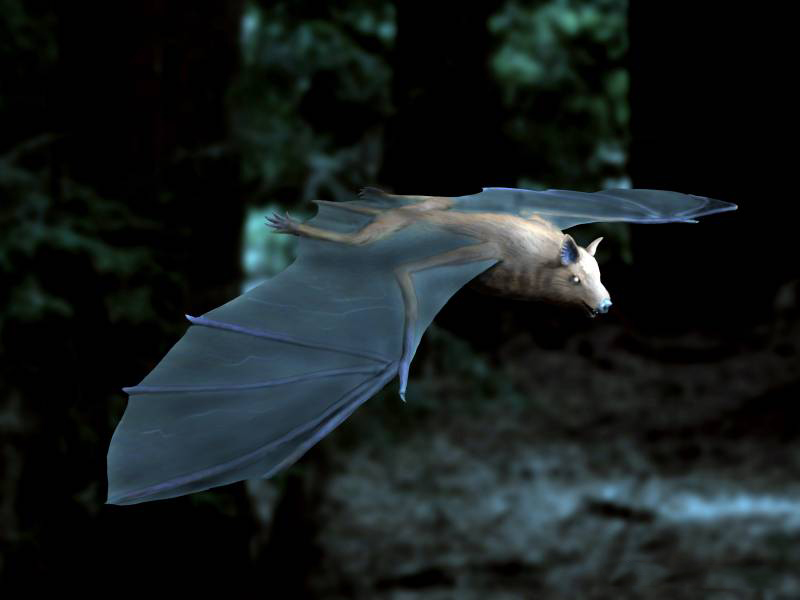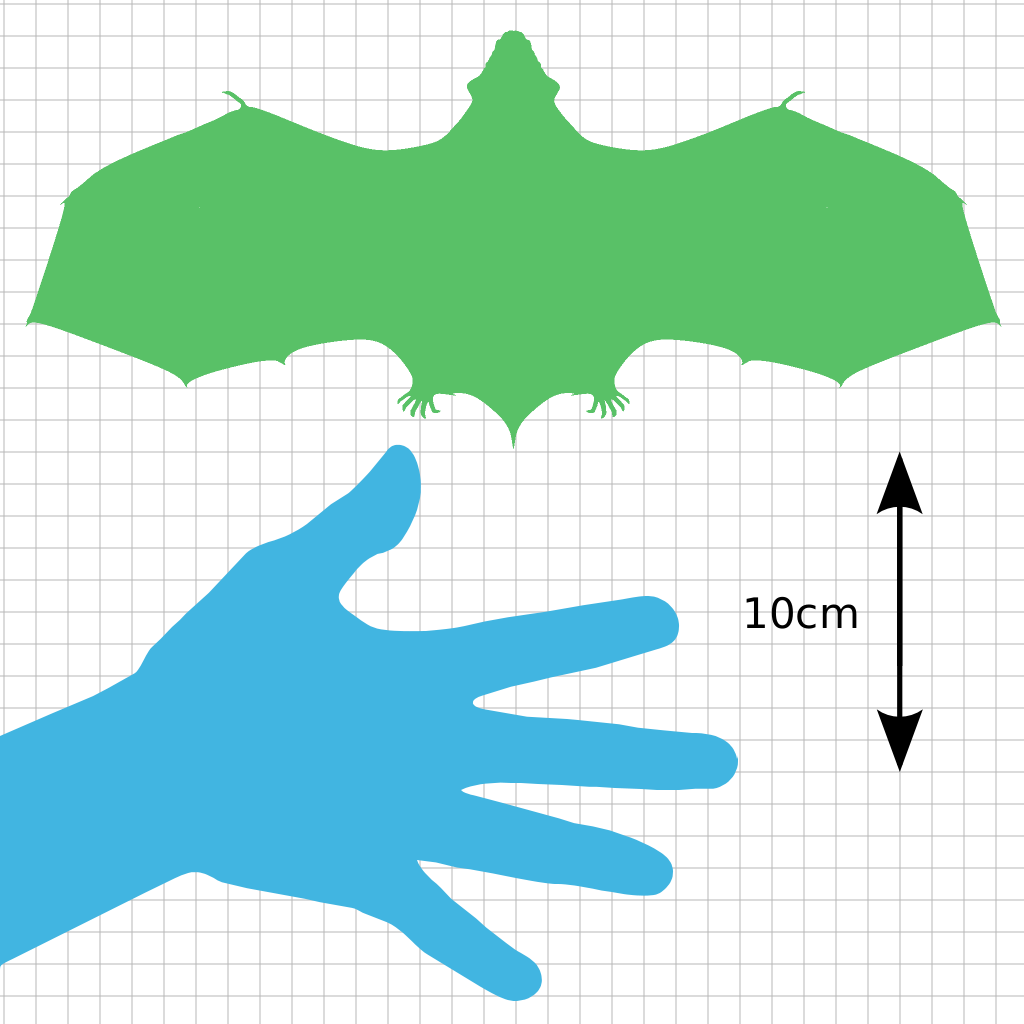|
Palaeochiropteryx Tupaiodon
''Palaeochiropteryx'' ( ) is an extinct genus of bat from the Middle Eocene of Europe and North America. It contains three very similar species – ''Palaeochiropteryx tupaiodon'' and ''Palaeochiropteryx spiegeli'', both from the famous Messel Pit of Germany, as well as ''Palaeochiropteryx sambuceus'' from the Sheep Pass Formation (Nevada, United States). They are usually found complete and exceptionally preserved, even retaining the outlines of their fur, ears, and wing membranes. They are one of the oldest bats known, existing around 48 million years ago. Despite this, they were already quite advanced, showing evidence of the ability to hunt by echolocation like modern insect-eating bats. ''Palaeochiropteryx'' were small bats, with a wingspan between . Their wings were short but broad, indicating an adaptation for slow but highly maneuverable flight beneath forest canopies and among dense vegetation. They preyed mostly on moths and caddisflies and were probably nocturnal. ... [...More Info...] [...Related Items...] OR: [Wikipedia] [Google] [Baidu] |
Lutetian
The Lutetian is, in the geologic timescale, a stage (stratigraphy), stage or age (geology), age in the Eocene. It spans the time between . The Lutetian is preceded by the Ypresian and is followed by the Bartonian. Together with the Bartonian it is sometimes referred to as the Middle Eocene Subepoch. Stratigraphic definition The Lutetian was named after Lutetia, the Latin language, Latin name for the city of Paris. The Lutetian Stage was introduced in scientific literature by French geologist Albert de Lapparent in 1883 and revised by A. Blondeau in 1981. The base of the Lutetian Stage is at the first appearance of the nanofossil ''Blackites inflatus'', according to an official reference profile (GSSP) established in 2011. Of two candidates located in Spain, the Gorrondatxe section was chosen.See thwebsite of Eustoquio Molinafor these candidates. The top of the Lutetian (the base of the Bartonian) is at the first appearance of calcareous nannofossils, calcareous nanoplankton s ... [...More Info...] [...Related Items...] OR: [Wikipedia] [Google] [Baidu] |
Moth
Moths are a group of insects that includes all members of the order Lepidoptera that are not Butterfly, butterflies. They were previously classified as suborder Heterocera, but the group is Paraphyly, paraphyletic with respect to butterflies (suborder Rhopalocera) and neither subordinate taxon is used in modern classifications. Moths make up the vast majority of the order. There are approximately 160,000 species of moth, many of which have yet to be described. Most species of moth are nocturnal, although there are also crepuscular and Diurnal animal, diurnal species. Differences between butterflies and moths While the Butterfly, butterflies form a monophyly, monophyletic group, the moths, comprising the rest of the Lepidoptera, do not. Many attempts have been made to group the superfamilies of the Lepidoptera into natural groups, most of which fail because one of the two groups is not monophyletic: Microlepidoptera and Macrolepidoptera, Heterocera and Rhopalocera, Jugatae a ... [...More Info...] [...Related Items...] OR: [Wikipedia] [Google] [Baidu] |
Greek Language
Greek (, ; , ) is an Indo-European languages, Indo-European language, constituting an independent Hellenic languages, Hellenic branch within the Indo-European language family. It is native to Greece, Cyprus, Italy (in Calabria and Salento), southern Albania, and other regions of the Balkans, Caucasus, the Black Sea coast, Asia Minor, and the Eastern Mediterranean. It has the list of languages by first written accounts, longest documented history of any Indo-European language, spanning at least 3,400 years of written records. Its writing system is the Greek alphabet, which has been used for approximately 2,800 years; previously, Greek was recorded in writing systems such as Linear B and the Cypriot syllabary. The Greek language holds a very important place in the history of the Western world. Beginning with the epics of Homer, ancient Greek literature includes many works of lasting importance in the European canon. Greek is also the language in which many of the foundational texts ... [...More Info...] [...Related Items...] OR: [Wikipedia] [Google] [Baidu] |
Palaeochiropterygidae
Palaeochiropterygidae is a family of extinct bats. It was originally erected by the Swiss naturalist Pierre Revilliod in 1917 after discoveries of ''Palaeochiropteryx'' fossils from the Messel Pit of Germany. Palaeochiropterygidae was merged into Archaeonycteridae by Kurten and Anderson in 1980, but modern authorities specializing in bat fossils maintain the distinction between the two. It was classified to the unranked clade Microchiropteramorpha by Smith ''et al.'' in 2007. They existed from the Ypresian to the Lutetian ages of the Middle Eocene epoch (55.8 to 40.4 million years ago). Paleobiology Two species of Palaeochiropterygidae, ''Palaeochiropteryx tupaiodon'' and ''P. spiegeli'', are known from complete skeletons from the famous Messel Pit fossil deposits in Germany. ''Palaeochiropteryx tupaiodon'' is the most common mammal found at Messel. An additional species of ''Palaeochiropteryx'', ''P. sambuceus'', has been described from the middle Eocene of North America. A ... [...More Info...] [...Related Items...] OR: [Wikipedia] [Google] [Baidu] |
Family (biology)
Family (, : ) is one of the eight major hierarchical taxonomic ranks in Linnaean taxonomy. It is classified between order and genus. A family may be divided into subfamilies, which are intermediate ranks between the ranks of family and genus. The official family names are Latin in origin; however, popular names are often used: for example, walnut trees and hickory trees belong to the family Juglandaceae, but that family is commonly referred to as the "walnut family". The delineation of what constitutes a family—or whether a described family should be acknowledged—is established and decided upon by active taxonomists. There are not strict regulations for outlining or acknowledging a family, yet in the realm of plants, these classifications often rely on both the vegetative and reproductive characteristics of plant species. Taxonomists frequently hold varying perspectives on these descriptions, leading to a lack of widespread consensus within the scientific community ... [...More Info...] [...Related Items...] OR: [Wikipedia] [Google] [Baidu] |
Naturalist
Natural history is a domain of inquiry involving organisms, including animals, fungi, and plants, in their natural environment, leaning more towards observational than experimental methods of study. A person who studies natural history is called a naturalist or natural historian. Natural history encompasses scientific research but is not limited to it. It involves the systematic study of any category of natural objects or organisms, so while it dates from studies in the ancient Greco-Roman world and the mediaeval Arabic world, through to European Renaissance naturalists working in near isolation, today's natural history is a cross-discipline umbrella of many specialty sciences; e.g., geobiology has a strong multidisciplinary nature. Definitions Before 1900 The meaning of the English term "natural history" (a calque of the Latin ''historia naturalis'') has narrowed progressively with time, while, by contrast, the meaning of the related term "nature" has widened (see also ... [...More Info...] [...Related Items...] OR: [Wikipedia] [Google] [Baidu] |
Swiss People
The Swiss people (, , , ) are the citizens of the multi-ethnic Swiss Confederation (Switzerland) regardless of ethno-cultural background or people of self-identified Swiss ancestry. The number of Swiss nationals has grown from 1.7 million in 1815 to 8.7 million in 2020. More than 1.5 million Swiss citizens hold multiple citizenship. About 11% of citizens live abroad (0.8 million, of whom 0.6 million hold multiple citizenship). About 60% of those living abroad reside in the European Union (0.46 million). The largest groups of Swiss descendants and nationals outside Europe are found in the United States, Brazil, and Canada. Although the modern state of Switzerland originated in 1848, the period of romantic nationalism, Switzerland is not a nation-state and the Swiss are not a single ethnic group. Rather, Switzerland is a confederacy (') or ' ("nation of will", "nation by choice", that is, a consociational state), a term coined in conscious contrast to "nation" in the conv ... [...More Info...] [...Related Items...] OR: [Wikipedia] [Google] [Baidu] |
Messel
Messel is a municipality in the district of Darmstadt-Dieburg in Hesse near Frankfurt am Main in Germany. The village is first mentioned, as ''Masilla'', in the Lorsch codex. Messel was the property of the lords of Groschlag from ca. 1400 to 1799. After the extinction of the Groschlag male lineage, the village would have passed to the Archbishopric of Mainz but the population refused to accept this transition and paid homage to the daughters of the Groschlag family instead. The minister of the archbishopric, von Albini, consequently occupied the village with a force of 50 hussars. In 1806, the village fell to the Grand Duchy of Hesse. The nearby Messel pit is an important site for Eocene The Eocene ( ) is a geological epoch (geology), epoch that lasted from about 56 to 33.9 million years ago (Ma). It is the second epoch of the Paleogene Period (geology), Period in the modern Cenozoic Era (geology), Era. The name ''Eocene'' comes ... fossils. File:Messel (3).JPG, Signpost at ... [...More Info...] [...Related Items...] OR: [Wikipedia] [Google] [Baidu] |
Fossil
A fossil (from Classical Latin , ) is any preserved remains, impression, or trace of any once-living thing from a past geological age. Examples include bones, shells, exoskeletons, stone imprints of animals or microbes, objects preserved in amber, hair, petrified wood and DNA remnants. The totality of fossils is known as the ''fossil record''. Though the fossil record is incomplete, numerous studies have demonstrated that there is enough information available to give a good understanding of the pattern of diversification of life on Earth. In addition, the record can predict and fill gaps such as the discovery of '' Tiktaalik'' in the arctic of Canada. Paleontology includes the study of fossils: their age, method of formation, and evolutionary significance. Specimens are sometimes considered to be fossils if they are over 10,000 years old. The oldest fossils are around 3.48 billion years to 4.1 billion years old. Early edition, published online before prin ... [...More Info...] [...Related Items...] OR: [Wikipedia] [Google] [Baidu] |
Palaeochiropteryx NT
''Palaeochiropteryx'' ( ) is an extinct genus of bat from the Lutetian, Middle Eocene of Europe and North America. It contains three very similar species – ''Palaeochiropteryx tupaiodon'' and ''Palaeochiropteryx spiegeli'', both from the famous Messel Pit of Germany, as well as ''Palaeochiropteryx sambuceus'' from the Sheep Pass Formation (Nevada, United States). They are usually found complete and exceptionally preserved, even retaining the outlines of their fur, ears, and Bat wing, wing membranes. They are one of the oldest bats known, existing around 48 million years ago. Despite this, they were already quite advanced, showing evidence of the ability to hunt by Animal echolocation, echolocation like modern insect-eating bats. ''Palaeochiropteryx'' were small bats, with a wingspan between . Their wings were short but broad, indicating an adaptation for slow but highly maneuverable flight beneath forest Canopy (biology), canopies and among dense vegetation. They preyed mostly ... [...More Info...] [...Related Items...] OR: [Wikipedia] [Google] [Baidu] |





